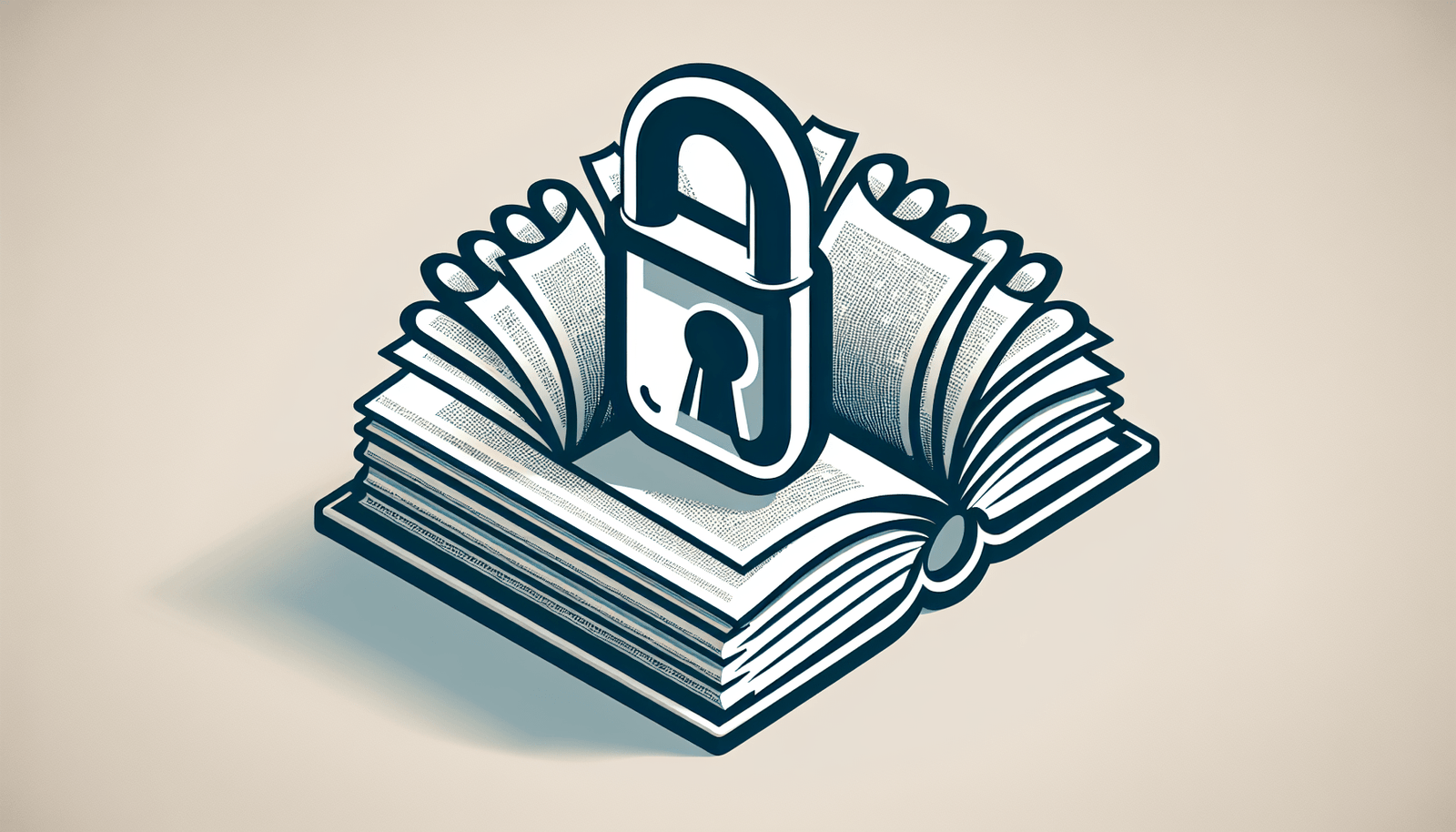In this article, you’ll discover practical steps to ensure that your book descriptions respect privacy and data protection standards. Your readers deserve not just engaging content but also the assurance that their personal information remains secure. We will explore strategies to help you craft book descriptions that comply with data protection laws, safeguard user data, and build trust with your audience. By the end, you’ll have a clear understanding of how to communicate effectively without compromising on privacy. Have you ever wondered how to ensure privacy and data protection in your book descriptions? In today’s digital age, safeguarding personal information is more crucial than ever. Whether you’re an author, publisher, or simply managing a bookstore, creating book descriptions that respect privacy can enhance trust and credibility among your audience.
The Importance of Privacy and Data Protection
Privacy and data protection are essential in our interconnected world. These elements build consumer trust and can greatly influence purchasing decisions. When people believe their personal information is secure, they’re more likely to engage with your content and make purchases. On the other hand, breaches of privacy can have severe consequences, including legal repercussions and damage to your reputation.
Understanding Book Descriptions
What Are Book Descriptions?
Book descriptions are concise summaries that give potential readers an idea of what to expect from a book. They usually include the book’s genre, plot highlights, main characters, and sometimes author credentials. These descriptions are a key marketing tool and can influence a reader’s decision to buy or borrow a book.
Why Is Privacy Consideration Necessary?
Incorporating privacy considerations in book descriptions is crucial because these descriptions often include names, places, and other sensitive information. This is even more critical when dealing with non-fiction works, memoirs, or any material featuring real-life people and events. Mismanagement of this information can lead to privacy issues and, in some cases, legal problems.
Best Practices for Ensuring Privacy and Data Protection
Limit Sensitive Information
One of the first steps in ensuring privacy in your book descriptions is to limit the amount of sensitive information you include. This is particularly important for non-fiction works.
Example Table
| Type of Information | Description | Best Practice |
|---|---|---|
| Names | Real names of individuals | Use pseudonyms or initials |
| Locations | Specific places (homes, workplaces) | Use general terms like “a city” or “a school” |
| Personal Details | Birthdates, addresses, phone numbers | Avoid unless absolutely necessary |
Use Pseudonyms and Anonymity
When your work involves real people, using pseudonyms or anonymizing information helps protect their privacy. Always obtain consent before including someone’s real name or details.
Steps to Use Pseudonyms:
- Identify sensitive information.
- Choose appropriate pseudonyms. Ensure these pseudonyms do not easily trace back to the real individuals.
- Maintain consistency. Use the chosen pseudonyms consistently throughout all related content.
- Document your choices. Keep a record of the pseudonyms used and the real names they represent for your reference.
Obtain Consent
Obtaining consent from individuals mentioned in your book is a critical step.
Ways to Obtain Consent:
- Written permission: A signed document is the most formal and secure method.
- Email consent: Written agreement via email can also be valid.
- Verbal consent: Although less secure, this can be sufficient in informal contexts; just be sure to document it.
Avoid Over-Sharing
In book descriptions, less is often more. Avoid sharing more information than necessary.
Questions to Determine Over-Sharing:
- Is this information crucial to the story?
- Can the same point be made with less detail?
- Will sharing this info put anyone at risk?
Employ Privacy Policies and Statements
If your book description is published online, include privacy policies or statements on the relevant web pages. This informs users how their data is used and assures them of protective measures.
Components of a Good Privacy Policy:
- Data Collection: What personal information is collected?
- Data Usage: How is the collected data used?
- User Rights: What rights do users have regarding their data?
- Contact Information: Who can users contact for more information?
Adhere to Data Protection Laws
Familiarize yourself with data protection laws applicable to your region, such as the GDPR in Europe or CCPA in California. Ensure your practices comply with these regulations to avoid legal issues.
Overview of Key Laws:
| Law | Region | Key Requirements |
|---|---|---|
| GDPR | Europe | Consent, data access, data portability, breach notification |
| CCPA | California | Data disclosure, opt-out options, right to delete data |
| HIPAA | USA (Health) | Privacy of health information, secure handling |
Use Data Minimization
Data minimization involves collecting only the data you need for your specific purpose. This principle reduces the risk of data breaches and ensures that unnecessary personal information isn’t mishandled.
Applying Data Minimization:
- Identify Purpose: Know why you need the data.
- Collect Essential Data Only: Avoid gathering data ‘just in case.’
- Securely Dispose of Unneeded Data: Properly delete any data that’s no longer needed.
Secure Storage Solutions
The way you store collected data matters. Implement secure storage solutions that include encryption, access control, and regular audits.
Examples of Secure Storage Solutions:
- Encrypted storage devices: USB sticks and hard drives with encryption.
- Password-protected files: Use strong, unique passwords.
- Cloud storage with encryption: Services like Google Drive or Dropbox, when used with additional encryption measures.
Regular Security Audits
Conduct regular security audits to identify vulnerabilities in your data protection practices. These audits can help you stay ahead of potential breaches and ensure ongoing compliance with relevant laws.
Components of a Security Audit:
- Identify Assets: Know what data and resources need protecting.
- Assess Risks: Determine potential threats and vulnerabilities.
- Implement Controls: Use risk assessments to establish control measures.
- Review Regularly: Regularly update and review your security measures.
Educate Your Team
If you work with a team, ensure they understand the importance of data protection and the specific measures you’ve put in place. Regular training can keep everyone on the same page.
Key Areas for Team Training:
- Data Protection Laws: Familiarize your team with applicable laws and regulations.
- Internal Policies: Ensure everyone understands your internal data protection policies.
- Response Procedures: Train your team on how to respond to potential breaches or data requests.
Real-Life Scenarios and Solutions
Fiction vs. Non-Fiction Scenarios
Fiction:
- Privacy Issues: Less common but may arise if inspired by real events.
- Solution: Always disclaim when names and events are fictionalized.
Non-Fiction:
- Privacy Issues: Common, particularly in memoirs, biographies, or true events.
- Solution: Use pseudonyms, obtain consent, and anonymize sensitive data.
Memoir Writing
When writing memoirs, privacy becomes particularly sensitive. Make sure to anonymize stories, especially those involving controversial or highly personal matters.
Steps for Memoir Writing:
- Obtain Consent: Get approval from anyone you mention.
- Use Pseudonyms: Replace real names with fictional ones.
- Limit Details: Provide only necessary information.
Children’s Books
In children’s books, you need to be cautious about sharing details that could expose the identity of any minors.
Precautionary Measures:
- Avoid Real Names: Use fictional names instead.
- Generalize Locations: Mention generic locations like “a park” rather than specific names.
- Parental Consent: Always get parental consent if you must include real children.
Leveraging Technology
Using Secure Platforms
Choose secure platforms for writing, storing, and sharing your content. This includes cloud services with strong security measures and content management systems that adhere to data protection standards.
Recommended Platforms:
| Platform | Features |
|---|---|
| Google Drive | Encryption, secure sharing |
| Dropbox | Two-factor authentication |
| Evernote | Encrypted notes |
| OneDrive | Advanced security features |
Encryption Tools
Use encryption tools to protect sensitive information. Encryption can prevent unauthorized access to your data.
Popular Encryption Tools:
- VeraCrypt: Open-source disk encryption.
- BitLocker: Full-disk encryption for Windows.
- FileVault: Full-disk encryption for Mac.
- ProtonMail: Encrypted email service.
Data Access Controls
Restrict access to sensitive information by implementing data access controls. Use roles and permissions to ensure only authorized individuals can access certain data.
Components of Access Control:
- Roles: Define what different roles (e.g., admin, editor) can access.
- Permissions: Assign permissions based on job requirements.
- Audit Logs: Keep records of who accessed what and when.
Conclusion
Ensuring privacy and data protection in your book descriptions is not just about compliance with laws; it’s about building trust with your audience and safeguarding their information. By implementing best practices, leveraging technology, and educating your team, you can create a secure environment that respects privacy and protects data. Whether you’re writing fiction, non-fiction, or children’s books, these steps will help you mitigate risks and promote a secure reading experience. Happy writing!



